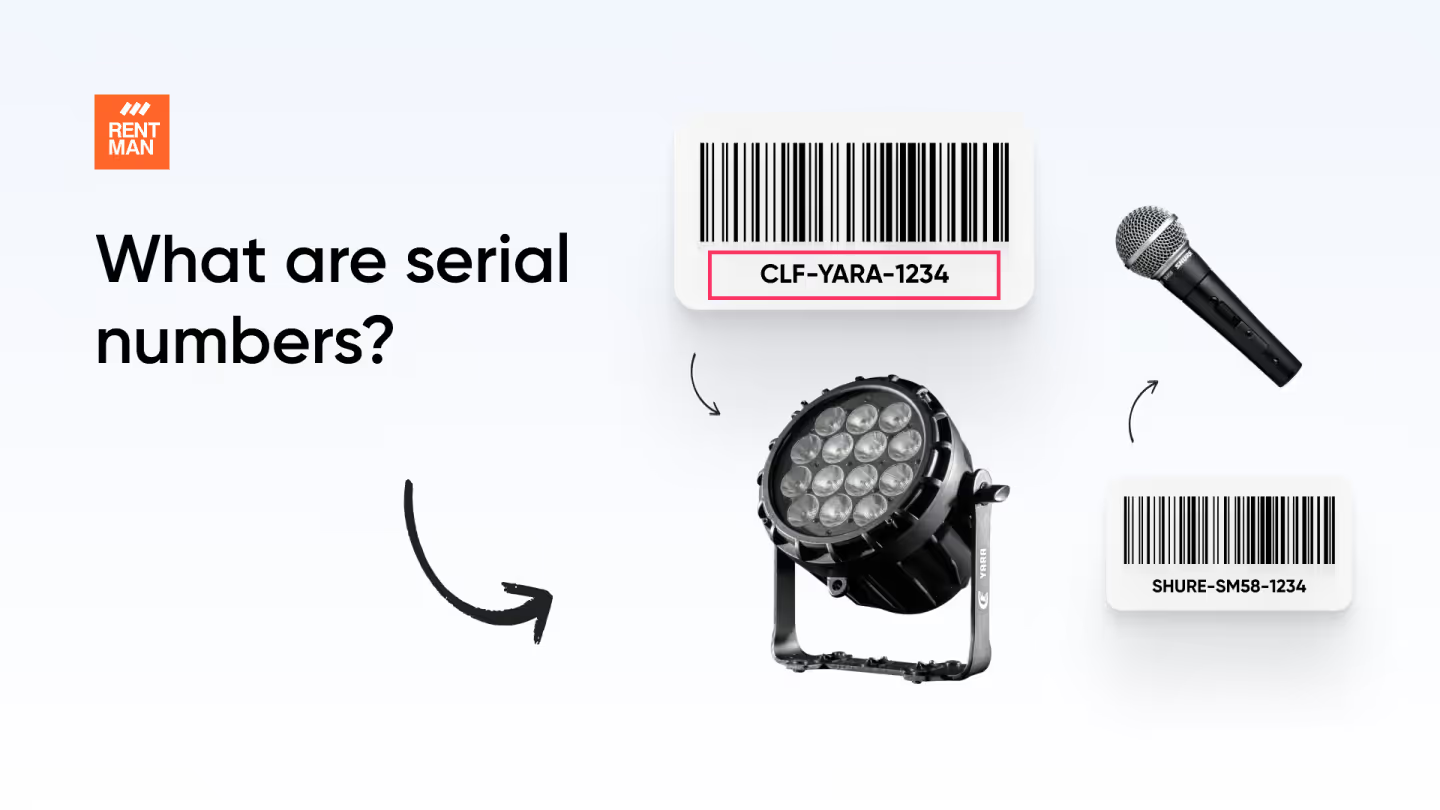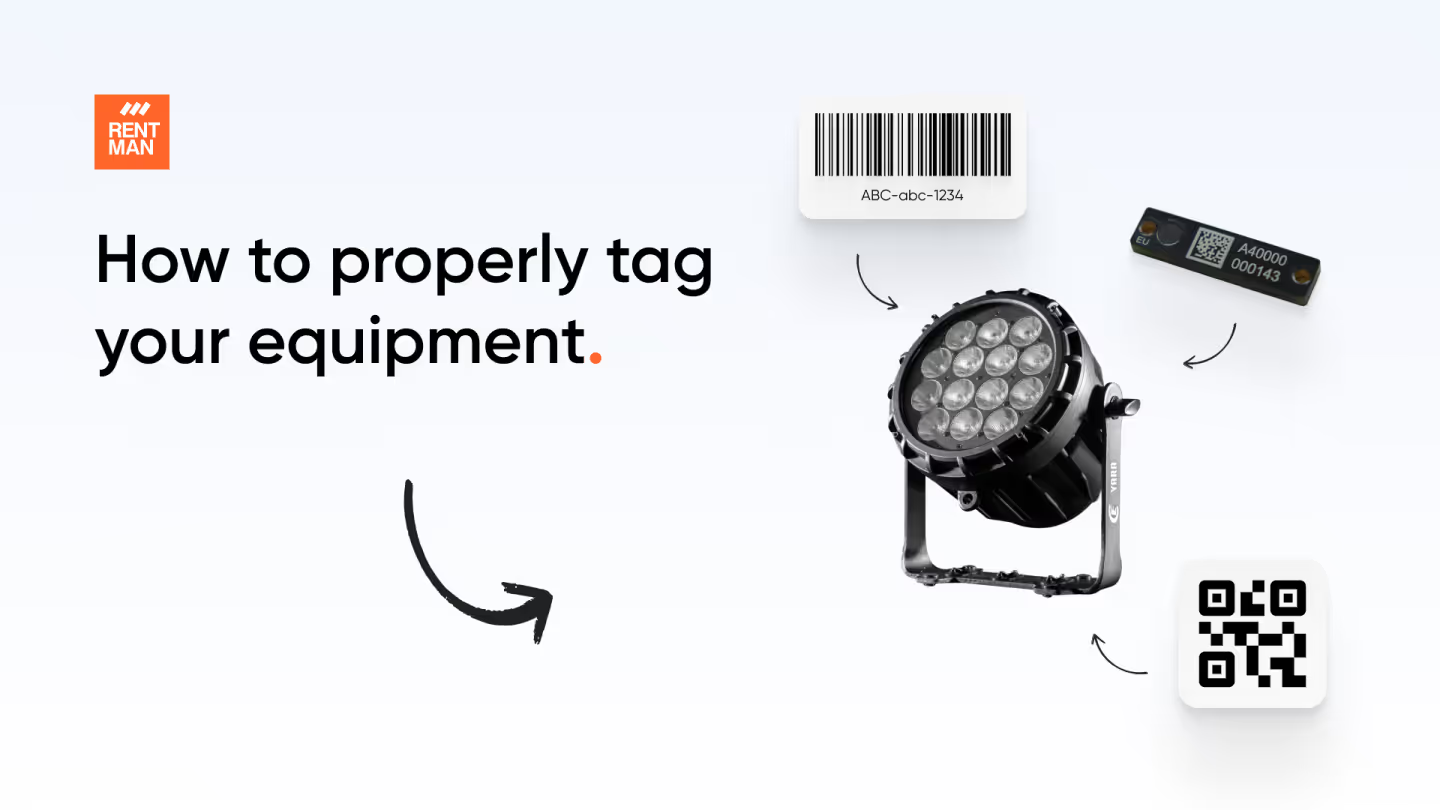How to keep track of inventory: 6 effective ways

As your once-budding equipment rental company blossoms, so do the growing pains. You remember the early days fondly - a close-knit team, a manageable stock of equipment, and the thrill of watching your clients' creative visions come alive with your equipment. But with success comes complexity, particularly regarding inventory counts . The question of how to keep track of your inventory, that nagging worry in the back of your mind, becomes a constant companion.
Imagine this: you've built a haven for aspiring filmmakers and seasoned professionals alike. Cameras, lighting rigs, and sound systems - the very tools that translate ideas into cinematic masterpieces - fill your shelves, meticulously maintained and ready to be deployed. But alongside these impressive pieces of technology lies another, often overlooked, category: the cables, the batteries, the memory cards, the countless small yet vital components that make everything function seamlessly, which are critical for maintaining inventory accuracy .
How do you ensure none of these elements, big or small, get lost in the daily shuffle of rentals and returns? How can you guarantee that every essential piece finds its way back to your shelves, ready for the next creative adventure? That's the supply chain management challenge we're about to tackle!
In the following guide, we'll delve into the world of efficient inventory management for equipment rental companies. We'll explore strategies and tools to help you maintain real-time visibility of your stock, from the high-end cameras to the last remaining battery charger. So, buckle up and get ready to discover how to keep your inventory under control, allowing you to focus on what truly matters - empowering your clients to bring their stories to life.
1. What is inventory tracking?
2. Why you need to track your inventory
3. Ways to track your inventory
4. Addressing equipment management challenges with inventory tracking
5. Best ways to track inventory for small businesses
6. Opt for resource management software
What is inventory tracking?
How do you manage inventory? It might seem like a straightforward concept - keeping track of your stuff, right? But within this broader umbrella lies a crucial component: inventory tracking. It's the difference between knowing you have a certain number of widgets in storage and pinpointing exactly which box, on which shelf, holds those specific widgets.
Inventory tracking is the process of monitoring your company’s inventory or stock of goods, raw materials, or assets. It's about maintaining a detailed and up-to-date record of every item, encompassing a vast array of activities for managing inventory itself. This includes assigning unique identifiers to each piece of inventory, meticulously logging their quantities, and constantly updating these records as items flow in and out of your stock.
Imagine a bustling warehouse filled with countless products. Inventory tracking acts like a meticulous filing system for this space. It allows you to pinpoint the exact location of a specific item, whether it's a high-value piece of equipment or a box of common components. This level of granular detail empowers you to make informed decisions about restocking, identify potential stockouts before they happen, and ultimately, streamline your entire supply chain.
By now, you might be starting to grasp the significance of inventory tracking. But why exactly is it that involves tracking so vital? Let's delve deeper and explore the reasons why robust inventory tracking is a cornerstone of efficient business operations and overall success.

Why you need to track your inventory
Effective inventory tracking is not just a good practice for businesses; it's a necessity. Here’s why:
- Inventory Demand Forecasting: Customer demand is rarely static. It can fluctuate due to seasonal changes, market trends, or unexpected events (like a pandemic). Inventory tracking allows you to adjust your stock levels in response to these fluctuations, ensuring you have enough of the right products on hand to meet customer demand without over- or understocking.
- Cost Control: Inventory represents a significant portion of a business's assets. Maintaining excess inventory ties up capital that could be used for other investments, while underestimating your inventory needs can lead to frequent rush orders and higher costs. Inventory tracking helps you strike a balance between having enough stock to meet demand and minimizing carrying costs.
- Operational Efficiency: Inaccurate inventory records can disrupt various aspects of your operations. For example, it can lead to your team accidentally planning broken or non-available items. Efficient inventory tracking ensures smooth operations by providing real-time insights into stock levels and reorder points.
- Prevent Theft and Loss: With equipment tracking, you keep a constant record of where your equipment is at all times. When your equipment does not arrive on time or is flagged as lost by one of your team members, you will be able to trace it back briefly, ensuring the assets' protection and financial integrity.
- Customer Satisfaction: Timely and accurate order fulfillment is crucial for maintaining customer trust and loyalty. Inventory tracking ensures that you have the right products available when customers need them, preventing stockouts and backorders.
Alright, by now, you should be convinced to keep a close eye on your equipment. So what is the best way to track inventory?

6 ways to track your inventory
Inventory tracking methods can vary depending on the size and complexity of your business. Here are some general ways to track your items using effective inventory management tools:
1. Barcoding and RFID Technology: Assign a unique barcode or RFID (Radio-Frequency Identification) tag to each piece of bulk equipment. Employees can then use handheld scanners or mobile devices to quickly scan items in and out, reducing the risk of manual errors and streamlining the tracking process.
Initial investment (in money, time and effort): High
Effectiveness: High
2. Regular Physical Audits: Conduct regular physical inventory audits to reconcile the physical count of equipment with the data in your inventory management system records. This helps identify discrepancies and theft, ensuring accurate records.
Initial investment: Low
Effectiveness: Low
3. Automated Alerts: Set up automated alerts for equipment maintenance schedules, return dates, low stock alerts, and low-stock levels. This ensures that equipment is well-maintained and available for rental when needed.
Initial investment: High
Effectiveness: High
4. Utilize QR Codes: QR codes can be affixed to equipment for easy scanning with a mobile device. These codes can link directly to information in your inventory management system, making it quick and convenient to access details about each piece of equipment.
Initial investment: Medium
Effectiveness: High (but only for serialized products)
5. Categorize and Label: Organize your inventory into categories (e.g., by type, size, or location) and label shelves, bins, or storage areas accordingly. This makes it easier for employees to locate and return equipment.
Initial investment: Medium
Effectiveness: Medium
6. Setting up an inventory ledger: This is an accessible way to track your inventory, especially for small to medium-sized businesses that may not require sophisticated inventory management systems. An inventory ledger is essentially a manual or digital record-keeping system that tracks the quantity and movement of your inventory items.
Initial investment: Low
Effectiveness: Low
Are you a small business owner yourself? Setting up an inventory ledger is not the only thing you need to take into consideration!
Best ways to track inventory for small businesses
For small businesses, efficient inventory tracking is both crucial and manageable. The best approach often involves a combination of practical strategies tailored to the business's unique needs and constraints.
Here’s a step-by-step guide on how to track inventory for small businesses:
1. Implement a basic inventory tracking system
With this system, you’ll be able to maintain an organized overview of your inventory transactions. Using pen and paper might seem like the easiest option, but in the long run, it will mostly cause you headaches.
2. Regularly update the records
It’s a time-consuming task, but doing this regularly right from the start will get you a long way. This will ensure high accuracy and will minimize potential challenges, such as shortages due to not enough equipment, broken or stolen items etc.
Remember! Inventory audits should also be done regularly.
3. Experiment with a QR / barcode inventory tracking system
Once your inventory tracking system is set in stone, it may be worthwhile to invest in QR / barcode tracking. If you print out stickers and stick them on your items, it will be easier to keep track of everything that goes in and out of the warehouse.
Tip! To avoid spending too much time scanning, only tag important items. For bulk items, such as cables, it is better to bundle them together in a flight case, and scan the case.
4. Think long-term, transition to a cloud-based system
This offers scalability, real-time insights, and automation capabilities, enabling you to optimize inventory levels, control costs, and provide better customer service. With inventory tracking systems such as Rentman, you will have more time to focus on more important tasks for your business.
---
Do you want to keep this guide on-hand? Make sure to download the infographic!
Addressing equipment management challenges with inventory tracking
Effective inventory tracking is crucial for ensuring the right equipment is delivered to productions on time and returned in good condition. Here are common challenges in inventory management and how tracking can help, especially when we generate reports.
1. Preventing packing mistakes
During busy seasons, crew members often make mistakes when picking and packing equipment. Items may be forgotten or misplaced, especially when using manual processes with packing slips or whiteboards. Implementing inventory tracking with barcode or serial number scanning helps ensure that each item is correctly identified, picked, and packed for the job, reducing errors.
2. Enhancing visibility and communication
Warehouse managers often struggle with a lack of a centralized view of projects, inventory, and schedules, making planning and communication difficult. Using an inventory tracking system provides real-time historical data on equipment availability and status, ensuring everyone involved stays informed and can adjust to changes efficiently.
3. Preventing loss, theft, and damage
Once equipment leaves the warehouse, tracking its use and return becomes challenging. By using inventory tracking tools, such as barcodes or RFID tags, warehouse managers can monitor each item's journey, ensure its return, and reduce instances of loss, theft, or damage. This visibility helps avoid unexpected replacement costs.
4. Simplifying processes for freelancers
Freelancers are often hired during peak seasons to help with packing. With intuitive inventory tracking systems, processes become easier for freelancers to follow, reducing confusion and mistakes. Scanning equipment with barcodes or RFID tags ensures that even temporary workers can efficiently handle inventory.
By implementing inventory tracking, warehouse managers can improve accuracy, reduce mistakes, and ensure equipment is always available when needed, contributing to a more efficient workflow and lower operational costs.
Conclusion
Effective inventory management is key to the smooth operation of your equipment rental business. By adopting modern tracking methods such as QR codes, barcodes, RFID, and cloud-based software, you can ensure that your inventory remains visible, organized, and ready for use at all times. This not only helps you prevent costly mistakes, such as misplaced or broken items, but also enhances overall efficiency and ensures that every piece of equipment, including necessary safety stock, is available when your clients need it most.
The ability to know exactly where each item is located and its status in real-time can significantly reduce the stress of managing complex logistics, allowing you to make informed decisions and keep your operations running smoothly.
Implementing these tracking solutions also allows for better resource allocation. You can identify which pieces of equipment are frequently used and which are underutilized, helping you optimize your inventory and make data-driven decisions about future purchases. This means you can invest in the equipment that truly adds value to your business while minimizing the costs associated with storing and maintaining less-used items.
Moreover, real-time inventory data can help you anticipate demand, ensuring that you are always prepared for busy periods and can meet customer needs without delay.
Taking advantage of these tools and strategies allows you to focus on what really matters: supporting your clients' creative visions with the right equipment, at the right time. By streamlining your inventory management processes, you reduce the likelihood of errors and improve the reliability of your service, which ultimately leads to higher client satisfaction.
An organized inventory system also contributes to better communication among your team members, as everyone has access to the same up-to-date information, reducing misunderstandings and ensuring that tasks are completed efficiently.
With an organized and transparent inventory management software, your business can thrive by minimizing disruptions, reducing operational costs, and maximizing resource availability. Effective inventory management systems not only boost internal productivity but also strengthen your reputation as a dependable partner for your clients, while also helping to reduce costs. Make inventory management a priority, and watch your rental operations reach new levels of efficiency, reliability, and customer satisfaction.
By investing in the right tools and processes, you can create a more resilient business that is well-equipped to handle growth and adapt to the ever-changing needs of the event and media production industry.
Opt for inventory management software
So let’s save some money and avoid unpleasant surprises. With inventory management software like Rentman that includes RFID systems, you keep real-time track of your equipment’s movements across locations, people, or teams.
Rentman is the operations management platform built to support event & media production teams.
FAQ
Frequently asked questions
No items found.
Previous blog posts

How a serial number works and why you should use it
How a serial number works and why you should use it

How to set Asset Tags for your Equipment: A Comprehensive Guide for Rental Businesses
How to set Asset Tags for your Equipment: A Comprehensive Guide for Rental Businesses

